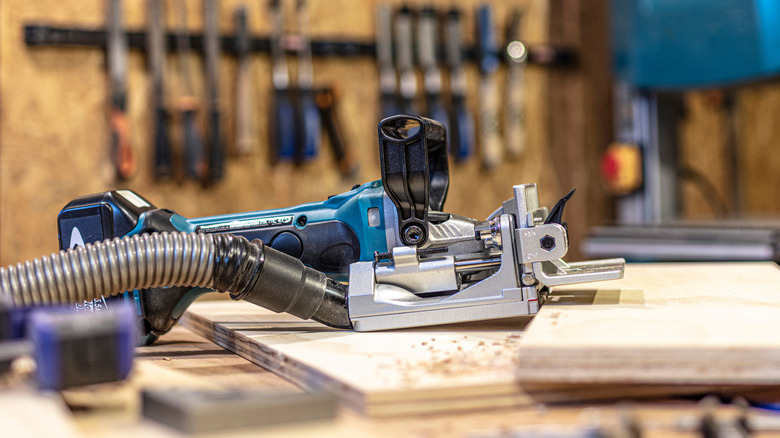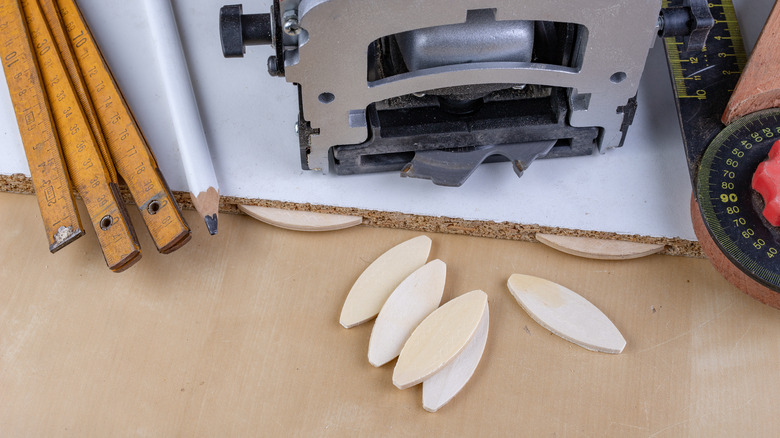Is It Worth Buying A Biscuit Joiner Tool? What You Should Know
If you're a woodworker, you know the importance of having the right tools for the job. These specialty items go well beyond the basic things every homeowner should have, like pliers and hammers. One of those key specialty tools you may consider purchasing is a biscuit joiner, a must-have item for those who want to clamp two items together with a tight joint without needing to use nails.
Is this a worthwhile tool for most people to purchase? The biscuit joiner can cost anywhere from $50 to $150 at Lowe's, but that's not a lot of money for a tool that can do things other products struggle to duplicate. Some people may use it daily or weekly, making it a good investment. On the other hand, it's certainly a tool that some people have very little reason to use in their workshops.
People who often do woodworking involving applications that won't undergo a significant level of stress can make use of a biscuit joiner. Projects like building drawers and boxes are a fabulous use of this specialty tool. It's a quick and simple kind of joint that's seamless and smooth. However, because you can cut the grooves required for this type of joint with other tools, like a router, you may not want to invest in a biscuit joiner. We'll help you decide whether you want to purchase one.
Reasons you may want to purchase a biscuit joiner tool
If you regularly build and repair drawers or lightweight cabinets, the biscuit joiner tool will make the job easier. You could use a finish nailer to construct the drawer, but the biscuit joiner method eliminates the nail holes. It simply allows the natural wood to be the focal point rather than allowing nail holes to draw the eye.
The biscuit joiner tool allows you to speed up your ability to connect pieces of wood versus other methods that do not use nails, like using dowels. This means someone doing quite a bit of this type of work can feel comfortable about buying a biscuit joiner, as it will enable you to work faster without sacrificing quality. Although some people prefer using dowels to connect two boards without using nails, this process takes longer than using the biscuit joiner, and dowels often require a hack to make perfectly straight holes in a woodworking project.
The most significant benefit of the biscuit joiner tool is its precision. It ensures the biscuit joint is placed in the perfect position every time. This is a straightforward machine, so you can achieve precision without a large learning curve. Trying to make such precise cuts by hand or with a router is a challenge, as the cuts may not perfectly line up each time.
Why buying a biscuit jointer tool may not be a good investment for you
People who spend most of their time building fences or putting up wall framing will not be able to take advantage of the biscuit joiner. This tool is not efficient for larger jobs like this, where using screws or nails is far easier, and there's no need to hide the nail holes for this type of work. These connections could also be placed under significant stress, which isn't appropriate for the biscuit joint method. The biscuit joiner really only works for items placed under minimal stress, like drawers.
Biscuit joiners work better for projects involving softwoods and plywood than hardwoods like oak or walnut. This tool also does not work to cut plastics or metal, adding some extra limitations to its use. In other words, if you want a tool that you can use for a wide range of DIY projects, the biscuit joiner probably doesn't fit the bill; it is much more of a specialized tool.
If you're new to woodworking, you may want to focus on simple woodworking projects for beginners that only require basic tools before advancing to more challenging projects where a biscuit joiner would be appropriate. Consider gaining some success with easy projects and determining whether you enjoy this hobby before spending money on specialized tools.



